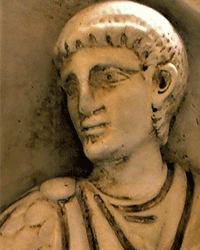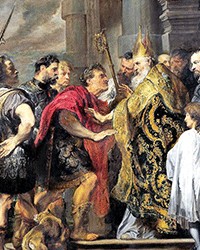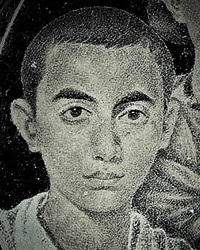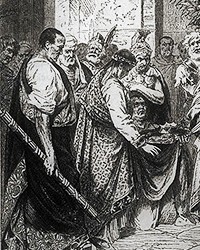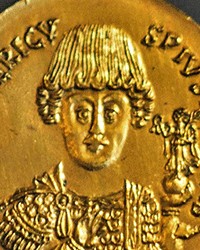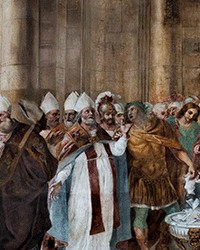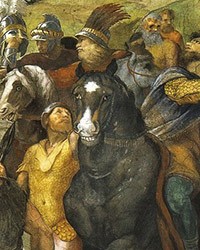Odoacer (433–493) – the fall of the empire, meaning how an intelligent illiterate became a Roman king
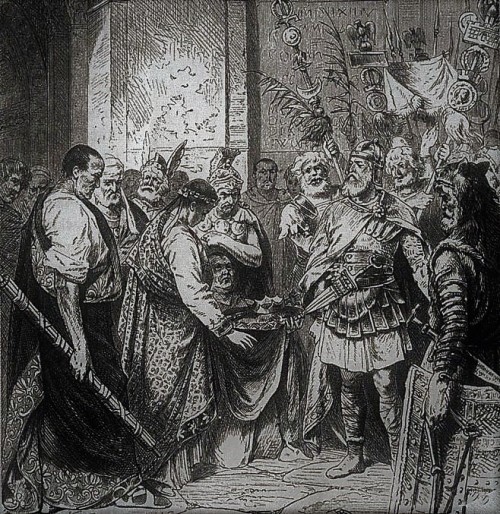
Odoacer and Emperor Romulus Augustulus, reproduction of a drawing by an unknown author, pic. Wikipedia
For us, his figure is closely associated with the fall of the Western Empire, but did the Romans truly experience this event as an end of an era? How is it possible that they gave their lives and their state into the hands of a barbarian? Why did unpaid soldier’s pay become the direct cause of the end of a centuries-long reign over the conquered lands and peoples? These are the questions, we may ask ourselves, reflecting on the subject of Odoacer.
For us, his figure is closely associated with the fall of the Western Empire, but did the Romans truly experience this event as an end of an era? How is it possible that they gave their lives and their state into the hands of a barbarian? Why did unpaid soldier’s pay become the direct cause of the end of a centuries-long reign over the conquered lands and peoples? These are the questions, we may ask ourselves, reflecting on the subject of Odoacer.
When the power of the Huns was broken, its remains – soldiers of German origin looking for work, Skirians or Rugians, quickly found it. The Western Empire was in dire need of bold and determined men-at-arms. At the head of the formed allied regiment, stood the descendant of one of Attila’s old generals, the prince of Skirians – Odoacer, who gained respect also of the Romans themselves. However, when due to constant financial problems, with which the then emperors struggled, Odoacer’s armies were not regularly paid, as compensation he demanded lands in Italy, and when he was dismissed with nothing, he began a revolt. As it turned out it became a pretext to attain greater glory. In times of the late empire (after Emperor Valentinian III) in the badly and irregularly paid army, military coups were nothing new. In truth they were a norm rather than an exception. Odoacer then did exactly, what only slightly earlier was done by one of the Roman generals, Orestes, beginning a rebellion against Emperor Julius Nepos (474-475) and putting his underage son – Romulus Augustus on the throne. However, Odoacer decided to follow a different path. He could not have declared himself emperor, since the previously overthrown by Orestes emperor was still alive and such a usurpation would have definitely caused a reaction of the Emperor of the Eastern Empire, would be an insult to the Senate and would be looked upon disfavorably by the Roman elites. Thus, he had an excellent, a nearly ingenious idea. However, prior to putting it into effect he had to set the stage. In August of 476 he led his rebellious forces, promising his soldiers one-third of the lands in Italy. Immediately after the protectors of the young Emperor Romulus Augustus – Orestes and Paul - were eliminated, while the emperor himself, at that time a teenager was dethroned on September 4th. The next step was quite a bit more difficult and it must be admitted that it was well thought-out. In the year 477 Odoacer returned the imperial insignia of the Emperor of the Western Empire to Constantinople, informing the then emperor in the East, that “there is no need to maintain a separation of powers and that one emperor is enough for both lands”. The senators sent with the delegation were tasked with convincing Zeno, that Odoacer is a man who represents stable power, sensibility and experience, deserving the nobilitating title of patrician, which was bestowed by the emperor upon outstanding military leaders who held actual power in the empire. This proposal was not without merit and definitely tempting to the Emperor of the East, who in this way became a ruler of the newly unified empire. Even more so, because Zeno, taking the imperial insignia of the emperors of the West, agreed to the rule of the barbarian, but believing that he would only tolerate him, until he himself had enough power to defeat him. He did mention Julius Nepos, but it seems only pro forma, since in referring to Odoacer as patrician in his return letter, he allowed for the usurpation and confirmed his sovereignty over him. That is at least how Odoacer understood it.
In this way, he became the representative of the emperor in Italy, in the newly united empire. Initially Odoacer did not bear any title, which is testified to by the coins minted for him with simply his name. After the death of Julius Nepos he officially declared himself as king of Italy (rex) and this title was officially approved by the ruler of the Eastern Roman Empire.
It must be admitted, that the inhabitants of the West themselves in placing themselves under the protection of the Emperor of the East, since that is how they understood this change in situation, could have seen a chance to protect their properties, threatened by constant struggles for power and influence. They were still citizens of Imperium Romanum. What about the loss of their own emperor? – we could ask. Well, the last few decades had showed that the power of the emperors, even of those who had ruled for a long time, was in truth illusionary. They will figureheads, while the real power was held by the patricians – the de facto leaders of the army – the grey eminencies of the then politics. For the inhabitants of Rome another change at the top did not have any real significance. In Rome, Odoacer ruled through his prefects. The rich landowners – senators desired above all peace in the land. They still enjoyed the respect of the populace, as before they constituted a closed circle, made up of the same surnames and occupied with the passing of laws. The new king did not interfere in matters of the Church – he collaborated with it, although he himself was an Arian (Arianism). A leftover of his rite is the erected in 470 and still existing today Church of Sant’Agata ai Monti, designated for the commune of Arians who had lived in Rome at that time. The pope became more and more independent and it was he, who with each passing day became not only the spiritual but also the actual ruler of the city. Odoacer surrounded by a caste of his warriors, ruled over Italy and a small part of Gallia Narbonensis, from Ravenna. It must be admitted, that he did not intend – neither legally, nor administratively – to destroy anything that the Romans had created. Even the granting of land which had earlier been promised to his warriors took place without too much drama, meaning large-scale expropriations of private properties. He was reasonable and respected the law and tradition. In creating himself to be a strong king, he could be seen as a guarantor of peace, stability and Christian virtues. The last emperor, Romulus Augustus, was not as could have been expected killed by him, but was rather sent to Campania, where he was paid out pension until the end of his life. History continued on and most likely not many people realized that the year 476 would in the history of the world be remembered as one of the most important dates, marking the end of antiquity.
Dark clouds started to gather over Odoacer’s head only when in 489 the Ostrogoth leader Theodoric the Great entered Italy and advanced on Ravenna. After a two-year siege, with starvation as an alternative, Odoacer surrendered. However, this did not amount to much. The capitulation signed by him in the presence of the bishop of Ravenna, assumed that he would rule Italy jointly with Theodoric. However, ten days later he was insidiously killed, along with his son, while his wife died in prison.
He was buried near the Jewish synagogue in Ravenna. Thus ended the nearly seventeen-year input of Odoacer into world history.




